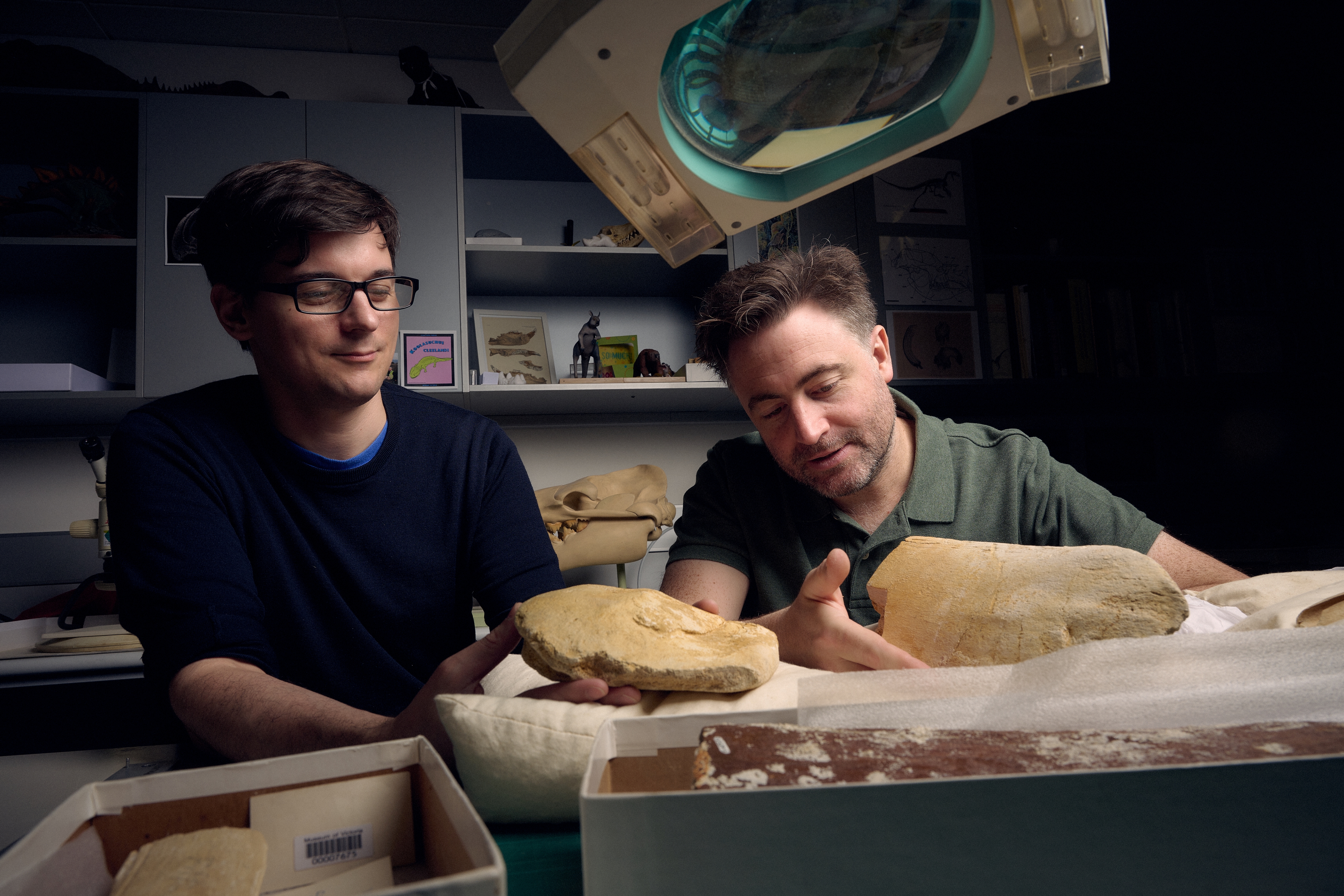A fossil whale jaw found on the banks of Australia’s Murray River is much larger than was considered possible for such an old fossil. Together with other surprisingly big southern fossil whales, the find suggests whales started growing in the Southern Hemisphere long before they did in the North.
It also suggests the baleen whales, a group including the largest animals of all time, are much more ancient than previously suspected. The reason their presence was not acknowledged earlier was a problem that bedevils many areas of science: Northern Hemisphere bias.
Blue whales can reach 30 meters (98 feet) long, but this is thought to have been a relatively recent development in evolutionary time. The rise of the huge baleen whales, which feed off vast catches of krill rather than hunting individual fish or mammals like their toothed counterparts, has been dated to around 19 million years ago.
Dr James Rule and Dr Erich Fitzgerald with the two surviving pieces of a 19 million-year-old whale jaw, revealing some whales in those days were much bigger than previously recognized.
Image credit: Eugene Hyland, Museums Victoria
Dr James Rule of Monash University told IFLScience that an apparently plausible story was previously accepted about the baleen whales’ rise to size.
The period at which the first truly large Northern Hemisphere whales were found coincides with the start of the Ice Age. It’s also about the time the megalodon disappeared, potentially making the oceans a bit safer for larger beasts. It also coincides with the disappearance of some other whale families.
This all created a neat picture beloved of Northern Hemisphere palaeontologists in which baleen whales seized the new niche and just kept on growing, rapidly evolving to their current immense size.
Compared to a modern fin whale, the Murray River whale doesn’t look quite so impressive, but you have to start somewhere.
Image credit: Art by Ruairidh Duncan, graphic by Rob French, Museums Victoria
Those responsible for this tale left out just one thing – most of the world’s oceans are in the Southern Hemisphere, including the exceptionally productive waters of the Antarctic Circumpolar Current.
Back in 1921, the front of a lower jaw was found on the banks of the Murray River and taken to Museums Victoria. There, it sat neglected for almost a century until the appointment of Dr Erich Fitzgerald, a cetacean specialist who started surveying the museum’s archives for anything whale-related. Fitzgerald suspected the fossil might be significant, and suggested it to Rule when he was looking for a student project.
Rule and Fitzgerald found the tips of baleen whales’ jaws are in proportion to their body length. Based on this, they calculated the specimen came from a 9-meter (30 foot) whale.
By modern standards that’s modest, but it shatters the 5-meter ceiling thought to have existed 19 million years ago when the sediments in which the bone was found were laid down.
“This was the time when the Southern Ocean was just starting to form and modernize,” Rule told IFLScience. “The [larger] whales probably found there was more food there and no need to go elsewhere.”
Although big whales may not have crossed the equator, this individual was a long way from the most krill-rich waters off Antarctica – Australia was further south then, but not by that much.
The higher seas of the era had flooded much of what is now South Australia and the whale would have been swimming in a shallow coastal sea when it died. “The waters were unusually shallow for a whale of this size,” said Rule, but with just one specimen, the team can’t tell if the whale was lost, lived in the area permanently, or had migrated to warmer waters to breed, as many modern whales do.
Northern Hemisphere whales are thought to have experienced a long period of size stability, followed by rapid growth. It seems likely this took place when the Southern Hemisphere whales crossed the equator.
Image credit: Art by Ruairidh Duncan, Museums Victoria
Fossil hunting off Antarctica comes with obvious difficulties, so we may never know much about these early giants in what was probably their home territory. However, Rule told IFLScience that discoveries from South Africa, Peru, and New Zealand suggest a much slower expansion in baleen whale size than has been imagined across the Southern Hemisphere. Once planetary conditions made the north another suitable home, some migrated there, creating the impression of a sudden burst of size.
This had been missed because only 19 percent of reported whale fossils are from north of the equator.
“The Southern Hemisphere, and Australia in particular, have always been over-looked frontiers for fossil whale discovery,” Fitzgerald said in a statement.
Noting that without Fitzgerald’s appointment, the vital piece of jaw would still be sitting ignored, Rule told IFLScience; “It’s always good to have more scientists. If there are more scientists there is more science done.”
The study is published in Proceedings of the Royal Society B.
Source Link: Early Giant Baleen Whales Were Hiding Out In The Southern Hemisphere
